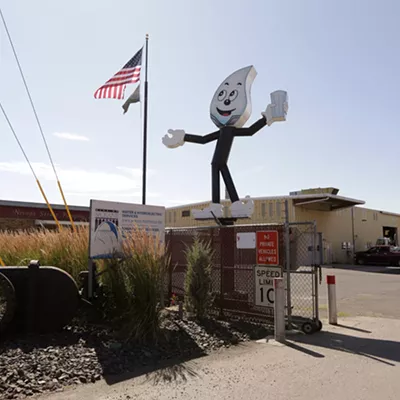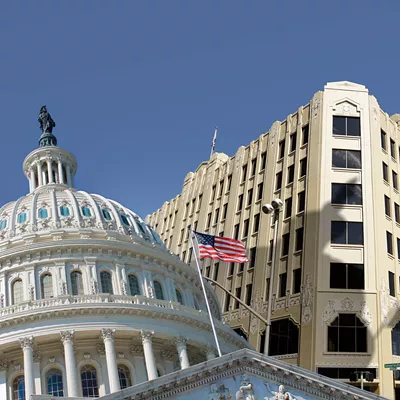Publicly, Spokane Mayor Nadine Woodward's administration doesn't sound particularly panicked about the budget this year.
"It's going to be tighter than in previous years," says Chief Financial Officer Tanya Wallace. "We're still showing some pretty good revenue growth, even though the market is contracting."
So it's striking that City Council members left and right, along with former city budget officials, are hammering the alarm button.
Matt Boston, the council's budgeting manager, says the city's own optimistic numbers from August show that city projects raising $13.7 million less next year than it's proposed spending. The administration's "PR spin" on the budget gap, he argues, is like a pilot telling passengers "don't focus on that wing that just fell off."
Council President Breean Beggs says the city potentially faces a $30 million deficit. And conservative Councilman Michael Cathcart's deficit estimate is even more dire: up to $40 million.
"The public has zero understanding of how bad our budget is right now," says Cathcart, adding that he's proposed a 15 percent cut to the city budget.
In this strange new post-pandemic economy, Spokane may have already reversed one of the previous mayor's biggest achievements. David Condon, mayor from 2012-19, was cheered for finally fixing the city's "structural budget gap" — chanting a 3 percent mantra of growth, and hammering down city spending until it fell in line with the city's revenue.
But Boston and council members say the gap is back. For the foreseeable future, our costs are growing faster than the money we're taking in.
"A year ago we said, 'We are going toward a cliff,'" says Boston. "I had many direct conversations saying we need to worry about this."
THE BAD TIMES
Few people recall 2004 or 2005 as an economic disaster in Spokane, but it was in Spokane City Hall.
Back then, the Inlander referred to the structural gap problem as the city's "dirty little secret for decades."
The city's expenses were growing nearly twice as fast as its revenue. A projected $6 million deficit in August 2004 had doubled by October. And since the city can't legally run a deficit, out came the ax.
"One hundred fifty-two full-time equivalents eliminated," says Gavin Cooley, who was the city's CFO for 17 years, including under Condon. "Brutal."
But the cuts were just triage. They hadn't cured the disease. With costs still increasing faster than revenue, another round of brutal cuts were inevitable.
"Psychologically, it's devastating." Cooley says. "And the minute you're done with it, the CFO walks up and says, 'Guess what? We have another deficit next year.'"
It wasn't until Condon, who could not be reached for comment, was elected that the budget gap was finally solved. Through negotiations with the local unions, City Hall capped salaries and benefits from growing much faster than 3 percent a year, the long-term average of the city's revenue growth.
But that victory was tenuous.
"Gavin used to say, 'You're one bad labor contract away from a structural gap again," says Tim Dunivant, the budget director under Condon.
A MILLION LITTLE THINGS
To be clear, there's a lot of reasons that the city's finances have been having problems.
The pandemic. Inflation. Gas price hikes. Using one-time funds for ongoing expenses, like when the city tapped into COVID relief funds to cover the new Trent homeless shelter's operating costs.
But the biggest issue budget hawks are watching is the latest round of union contracts.
Instead of holding the unions to the Condon administration's 3 percent mantra for wage bumps, the city has increased salaries for the major unions — from the fire union to the police guild to the thousand-city-employee-strong Local 270 — by closer to 5 percent, according to city data.
By the time the city shells out the $9 million in back pay owed to the unions, it will have blown through over 80 percent of its general reserve funds, leaving the rainy day fund almost completely dry.
Boston's worried it could harm the city's bond rating, which can hinder the city's ability to get favorable loan terms for things like street and park improvements.
While Wallace, the city's CFO, doesn't agree that union negotiations broke the city's budget, she says the city "did not anticipate the labor market that we experienced at all."
Cooley agrees. During a labor shortage, labor has the upper hand.
"They are dealing with a competitive marketplace that I never had to deal with," Cooley says. "That would have been very difficult to hold to that principle, with current market conditions."
But some also sees strategic mistakes. Ben Stuckart, who was criticized for being too cozy with the fire union during his tenure as council president, describes grabbing beers with his firefighter friends in the union as they crowed about what a great deal they got.
"Halfway through the conversation they said, 'Did you hear about that contract?'" Stuckart says. "'You never would have voted for that shit. We got things we never would have gotten from you!'"
The key to previous union negotiations, Cooley says, was sitting down with labor and putting the city's six-year financial projections "front and center."
But while Wallace says the city kept those projections in mind, they were not "necessarily used in the detailed negotiations."
There might've been a good reason for that. Condon's 3 percent mantra came at a cost: You can only run departments so lean before they begin starving.
Randy Marler, president of the fire union, suggests past contracts were "short-term fixes" that have damaged the city over time.
"Our ability to recruit and attract high-quality employees has suffered," Marler says. "We've been way too lean for way too long."
From Community, Housing & Human Services to human resources to the fire department, low staffing levels in recent years have either sent employees fleeing for the exits or sent overtime costs careening out of control.
Wallace says that the city is choosing its employees over other investments that could be made. She adds that the concept of a structural gap is "constantly evolving. And we're going to evolve with it."
Predicting exactly what is going to happen in the future, Wallace suggests, is impossible. But that's why folks like Boston and Dunivant say it's important to be conservative.
Dunivant, for one, is not above predicting: "The economy's coming to a screeching halt here pretty soon." ♦


























